Evo Morales
| Evo Morales | |
|---|---|
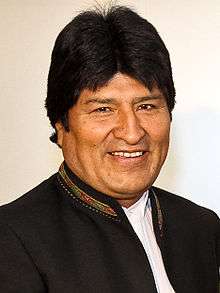 | |
| 80th President of Bolivia | |
|
Assumed office January 22, 2006 | |
| Vice President | Álvaro García Linera |
| Preceded by | Eduardo Rodríguez |
| Leader of the Movement for Socialism | |
|
Assumed office January 1, 1998 | |
| Preceded by | Position established |
| Personal details | |
| Born |
Juan Evo Morales Ayma 26 October 1959 Isallawi, Bolivia |
| Political party | Movement for Socialism |
| Children |
Eva Liz Álvaro |
| Parents |
Dionisio Morales Choque María Ayma Mamani |
| Residence | Palacio Quemado |
| Religion |
Indigenous Andean religion Roman Catholicism |
| Signature |
 |
| Military service | |
| Allegiance |
|
| Service/branch |
|
| Years of service | 1977–1978 |
| Unit | Fourth Ingavi Cavalry Regiment |
Juan Evo Morales Ayma (born October 26, 1959), popularly known as Evo (Spanish pronunciation: [ˈeβo]), is a Bolivian politician and cocalero activist who has served as President of Bolivia since 2006. Widely regarded as the country's first president to come from the indigenous population,[lower-alpha 1] his administration has focused on the implementation of leftist policies, poverty reduction, and combating the influence of the United States and multinational corporations in Bolivia. A democratic socialist, he is the head of the Movement for Socialism (MAS) party.
Born to an Aymara family of subsistence farmers in Isallawi, Orinoca Canton, Morales undertook a basic education before mandatory military service, in 1978 moving to Chapare Province. Growing coca and becoming a trade unionist, he rose to prominence in the campesino ("rural laborers") union, campaigning against U.S. and Bolivian attempts to eradicate coca as a part of the War on Drugs, which he denounced as an imperialist violation of indigenous Andean culture. He repeatedly engaged in anti-government direct action protests, resulting in multiple arrests. Morales entered electoral politics in 1995, became the leader of the MAS and was elected to Congress. His campaign focused on issues affecting indigenous and poor communities. He advocates land reform and redistribution of gas wealth and gained increased visibility through the Cochabamba protests and gas conflict. In 2002 he was expelled from Congress for encouraging protesters, although he came second in that year's presidential election.
Once elected in 2005, Morales increased taxation on the hydrocarbon industry to bolster social spending, emphasising projects to combat illiteracy, poverty, racism, and sexism. Vocally criticizing neoliberalism and reducing dependence on the World Bank and International Monetary Fund, his administration oversaw strong economic growth while following a policy termed "Evonomics" which sought to move from a liberal economic approach to a mixed economy. Scaling back U.S. influence in the country, he built relationships with leftist governments in the Latin American pink tide and signed Bolivia into the Bolivarian Alliance for the Americas. Attempting to moderate the left-indigenous activist community, his administration also opposed the right-wing autonomist demands of Bolivia's eastern provinces. Winning a recall referendum in 2008, he instituted a new constitution that established Bolivia as a plurinational state and was re-elected in 2009. His second term witnessed the continuation of leftist policies and Bolivia's joining of the Bank of the South and Community of Latin American and Caribbean States. After becoming the world's oldest professional footballer by signing to a Bolivian team, he was again reelected in the 2014 general election.
Morales is a controversial world figure, lauded by his supporters as a champion of indigenous rights, anti-imperialism, and environmentalism. Praised for seriously reducing poverty and illiteracy in Bolivia, he has been internationally decorated with various awards. He has been criticised from many perspectives on the political spectrum: right-wing opponents have labelled his administration as authoritarian and radical, while leftist, indigenous, and environmentalist critics have accused him of failing to live up to many of his espoused values.
Early life and activism
Childhood, education and military service: 1959–78

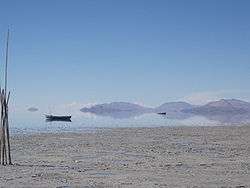
Morales was born in the small rural village of Isallawi in Orinoca Canton, part of western Bolivia's Oruro Department, on 26 October 1959.[9] One of seven children born to Dionisio Morales Choque and Maria Ayma, only he and two siblings, Esther and Hugo, survived past childhood.[10] His mother almost died from a postpartum haemorrhage following his birth.[8] Ethnically identifying as a member of the indigenous Aymara people, in keeping with Aymara custom, his father buried the placenta produced after his birth in a place specially chosen for the occasion.[8] His childhood home was a traditional adobe house,[11] and he grew up speaking the Aymara language, although later commentators would remark that by the time he had become president he was no longer an entirely fluent speaker.[12]
Morales's family were farmers; from an early age, he helped them to plant and harvest crops and guard their herd of llamas and sheep, taking a homemade soccer ball to amuse himself.[13] As a toddler, he briefly attended Orinoca's preparatory school, and at five began schooling at the single-room primary school in Isallawi.[14] Aged 6, he spent six months in northern Argentina with his sister and father. There, Dionisio harvested sugar cane while Evo sold ice cream and briefly attended a Spanish-language school.[15] As a child, he regularly traveled on foot to Arani province in Cochabamba with his father and their llamas, a journey lasting up to two weeks, in order to exchange salt and potatoes for maize and coca. [16] A big fan of soccer, at age 13 he organised a community soccer team with himself as team captain. Within two years, he was elected training coach for the whole region, and thus gained early experience in leadership.[17]
After finishing primary education, Morales attended the Agrarian Humanistic Technical Institute of Orinoca (ITAHO), completing all but the final year.[18] His parents then sent him to study for a degree in Oruro; although he did poorly academically, he finished all of his courses and exams by 1977, earning money on the side as a brick-maker, day labourer, baker and a trumpet player for the Royal Imperial Band. The latter position allowed him to travel across Bolivia.[19] At the end of his higher education he failed to collect his degree certificate.[18] Although interested in studying journalism, he did not pursue it as a profession.[20]
Morales served his mandatory military service in the Bolivian army from 1977 to 1978. Initially signed up at the Centre for Instruction of Special Troops (CITE) in Cochabamba, he was sent into the Fourth Ingavi Cavalry Regiment and stationed at the army headquarters in the Bolivian capital La Paz.[21] These two years were one of Bolivia's politically most unstable periods, with five presidents and two military coups, led by General Juan Pereda and General David Padilla respectively; under the latter's regime, Morales was stationed as a guard at the Palacio Quemado (Presidential Palace).[22]
Early cocalero activism: 1978–83
Following his military service, Evo returned to his family, who had escaped the agricultural devastation of 1980's El Niño storm cycle by relocating to the Tropics of Cochabamba in the eastern lowlands.[23] Setting up home in the town of Villa 14 de Septiembre, El Chapare, using a loan from Evo's maternal uncle, the family cleared a plot of land in the forest to grow rice, oranges, grapefruit, papaya, bananas and later on coca.[24] It was here that Morales learned to speak Quechua, the indigenous local language.[25] The arrival of the Morales family was a part of a much wider migration to the region; in 1981 El Chapare's population was 40,000 but by 1988 it had risen to 215,000. Many Bolivians hoped to set up farms where they could earn a living growing coca, which was experiencing a steady rise in price and which could be cultivated up to four times a year; a traditional medicinal and ritual substance in Andean culture, it was also sold abroad as the key ingredient in cocaine.[26] Evo joined the local soccer team, before founding his own team, New Horizon, which proved victorious at the August 2nd Central Tournament.[26] The El Chapare region remained special to Morales for many years to come; during his presidency he often talked of it in speeches and regularly visited.[27]

In El Chapare, Morales joined a trade union of cocaleros (coca growers), being appointed local Secretary of Sports. Organizing soccer tournaments, among union members he earned the nickname of "the young ball player" because of his tendency to organize matches during meeting recesses.[26] Influenced in joining the union by wider events, in 1980 the far-right General Luis García Meza had seized power in a military coup, banning other political parties and declaring himself president; for Morales, a "foundational event in his relationship with politics" occurred in 1981, when a campesino (coca grower) was accused of cocaine trafficking by soldiers, beaten up, and burned to death.[28] In 1982 the leftist Hernán Siles Zuazo and the Democratic and Popular Union (Unidad Democrática y Popular – UDP) took power in representative democratic elections, before implementing neoliberal capitalist reforms and privatizing much of the state sector with US support; hyperinflation came under control, but unemployment rose to 25%.[29] Becoming increasingly active in the union, from 1982 to 1983, Morales served as the General Secretary of his local San Francisco syndicate.[30] However, in 1983, Morales's father Dionisio died, and although he missed the funeral he temporarily retreated from his union work to organize his father's affairs.[31]
Fighting their War on Drugs, the U.S. government hoped to stem the cocaine trade by preventing the production of coca; they pressured the Bolivian government to eradicate it, sending troops to Bolivia to aid the operation.[32] Bolivian troops would burn coca crops and in many cases beat up coca growers who challenged them.[33] Angered by this, Evo returned to cocalero campaigning; like many comrades, he refused the US$2,500 compensation offered by the government for each acre of coca he eradicated. Deeply embedded in Bolivian culture, the campesinos had an ancestral relationship with coca and did not want to lose their most profitable means of subsistence. For them, it was an issue of national sovereignty, with the U.S. viewed as imperalists; activists regularly proclaimed "Long live coca! Death to the Yankees!" ("Causachun coca! Wañuchun yanquis!").[30]
General Secretary of the Cocalero Union: 1984–94
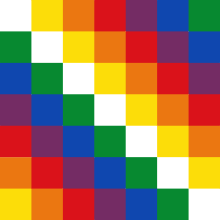
From 1984 to 1985 Morales served as Secretary of Records for the movement,[30] and in 1985 he became General Secretary of the August Second Headquarters.[30] From 1984 to 1991 the sindicatos embarked on a series of protests against the forced eradication of coca by occupying local government offices, setting up roadblocks, going on hunger strike, and organizing mass marches and demonstrations.[34] Morales was personally involved in this direct activism and in 1984 was present at a roadblock where 3 campesinos were killed.[35] In 1988, Morales was elected to the position of Executive Secretary of the Federation of the Tropics.[30] In 1989 he spoke at a one-year commemoratory event of the Villa Tunari massacre in which 11 coca farmers had been killed by agents of the Rural Area Mobile Patrol Unit (Unidad Móvil Policial para Áreas Rurales – UMOPAR).[35] The following day, UMOPAR agents beat Morales up, leaving him in the mountains to die, but he was rescued by other union members.[36] To combat this violence, Morales concluded that an armed cocalero militia could launch a guerrilla war against the government, but he was soon persuaded on an electoral path to change instead.[37] In 1992, he made various international trips to champion the cocalero cause, speaking at a conference in Cuba,[38] and also traveling to Canada, during which he learned of his mother's death.[39]
In his speeches, Morales presented the coca leaf as a symbol of Andean culture that was under threat from the imperialist oppression of the U.S. In his view, the U.S. should deal with their domestic cocaine abuse problems without interfering in Bolivia, arguing that they had no right trying to eliminate coca, a legitimate product with many uses which played a rich role in Andean culture.[40] In a speech on this issue, Morales told reporters "I am not a drug trafficker. I am a coca grower. I cultivate coca leaf, which is a natural product. I do not refine (it into) cocaine, and neither cocaine nor drugs have ever been part of the Andean culture."[5] On another, he asserted that "We produce our coca, we bring it to the main markets, we sell it and that's where our responsibility ends."[41]
Morales presented the coca growers as victims of a wealthy, urban social elite who had bowed to U.S. pressure by implementing neoliberal economic reforms.[40] He argued that these reforms were to the detriment of Bolivia's majority, and thus the country's representative democratic system of governance failed to reflect the true democratic will of the majority.[40] This situation was exacerbated following the 1993 general election when the centrist Revolutionary Nationalist Movement (Movimiento Nacionalista Revolucionario – MNR) won the election and Gonzalo Sánchez de Lozada became President. He adopted a policy of "shock therapy", implementing economic liberalization and widescale privatization of state-owned assets.[42] Sánchez also agreed with the U.S. DEA to relaunch its offensive against the Bolivian coca growers, committing Bolivia to eradicating 12,500 acres (5,100 ha) of coca by March 1994 in exchange for $20 million worth of US aid, something Morales claimed would be opposed by the cocalero movement.[43]
In August 1994 Morales was arrested; reporters present at the scene witnessed him being beaten and accosted with racial slurs by civil agents. Accused of sedition, in jail he began a dry hunger strike to protest his arrest.[44] The following day, 3000 campesinos began a 360-mile (580 km) march from Villa Tunari to La Paz. Morales would be freed on September 7, and soon joined the march, which arrived at its destination on 19 September, where they covered the city with political graffiti.[45] He was again arrested in April 1995 during a sting operation that rounded up those at a meeting of the Andean Council of Coca Producers that he was chairing on the shores of Lake Titicaca. Accusing the group of plotting a coup with the aid of Colombia's FARC and Peru's Shining Path, a number of his comrades were tortured, although no evidence of a coup was brought forth and he was freed within a week.[46] He proceeded to Argentina to attend a seminar on liberation struggles.[47]
Political rise
The ASP, IPSP and MAS: 1995–99
Members of the sindicato social movement first suggested a move into the political arena in 1986. This was controversial, with many fearing that politicians would co-opt the movement for personal gain.[48] Morales began supporting the formation of a political wing in 1989, although a consensus in favor of its formation only emerged in 1993.[49] On March 27, 1995, at the 7th Congress of the Unique Confederation of Rural Laborers of Bolivia (Confederación Sindical Única de Trabajadores Campesinos de Bolivia – CSUTCB), a "political instrument" (a term employed over "political party") was formed, named the Assembly for the Sovereignty of the Peoples (Asamblea por la Sobernía de los Pueblos – ASP).[50] At the ASP's 1st Congress, the CSUTCB participated alongside three other Bolivian unions, representing miners, peasants and indigenous peoples.[49] In 1996, Morales was appointed chairman of the Committee of the Six Federations of the Tropics of Cochabamba, a position that he retained until 2006.[51]
Bolivia's National Electoral Court (Corte Nacional Electoral – CNE) refused to recognize the ASP, citing minor procedural infringements.[49] The coca activists circumvented this problem by running under the banner of the United Left (IU), a coalition of leftist parties headed by the Communist Party of Bolivia (Partido Comunista Boliviano – PCB).[52] They won landslide victories in those areas which were local strongholds of the movement, producing 11 mayors and 49 municipal councilors.[49] Morales was elected to the National Congress as a representative for El Chapare, having secured 70.1% of the local vote.[51] In the national elections of 1997, the IU/ASP gained four seats in Congress, obtaining 3.7% of the national vote, with this rising to 17.5% in the department of Cochabamba.[53] The election resulted in the establishment of a coalition government led by the right-wing Nationalist Democratic Action (Acción Democrática Nacionalista – ADN), with Hugo Banzer as President; Morales lambasted him as "the worst politician in Bolivian history".[54]

Rising electoral success was accompanied by factional in-fighting, with a leadership contest emerging in the ASP between the incumbent Alejo Véliz and Morales, who had the electoral backing of the social movement's bases.[53] The conflict led to a schism, with Morales and his supporters splitting to form their own party, the Political Instrument for the Sovereignty of the Peoples (Instrumento Político por la Soberanía de los Pueblos – IPSP).[55] The movement's bases defected en masse to the IPSP, leaving the ASP to crumble and Véliz to join the centre-right New Republican Force (Nueva Fuerza Republicana – NFR), for which Morales denounced him as a traitor to the cocalero cause.[56] Continuing his activism, in 1998 Morales led another cocalero march from El Chapare to la Paz,[57] and came under increasing criticism from the government, who repeatedly accused him of being involved in the cocaine trade and mocked him for how he spoke and his lack of education.[58]
Morales came to an agreement with David Añez Pedraza, the leader of a defunct yet still registered party named the Movement for Socialism (MAS); under this agreement, Morales and the Six Federaciónes could take over the party name, with Pendraza stipulating the condition that they must maintain its own acronym, name and colors. Thus the defunct right wing MAS became the flourishing left wing vehicle for the coca activist movement known as the Movement for Socialism – Political Instrument for the Sovereignty of the Peoples.[59] The MAS would come to be described as "an indigenous-based political party that calls for the nationalization of industry, legalization of the coca leaf ... and fairer distribution of national resources."[60] The party lacked the finance available to the mainstream parties, and so relied largely on the work of volunteers in order to operate.[61] It was not structured like other political parties, instead operating as the political wing of the social movement, with all tiers in the movement involved in decision making; this form of organisation would continue until 2004.[62] In the December 1999 municipal elections, the MAS secured 79 municipal council seats and 10 mayoral positions, gaining 3.27% of the national vote, although 70% of the vote in Cochabamba.[59]
Cochabamba protests: 2000–02
In 2000, the Tunari Waters corporation doubled the price at which they sold water to Bolivian consumers, resulting in a backlash from leftist activist groups, including the cocaleros. Activists clashed with police and armed forces, in what was dubbed "the Water War", resulting in 6 dead and 175 wounded. Responding to the violence, the government removed the contract from Tunari and placed the utility under cooperative control.[63] In ensuing years further violent protests broke out over a range of issues, resulting in more deaths both among activists and law enforcement. Much of this unrest was connected with the widespread opposition to economic liberalization across Bolivian society, with a common perception that it only benefited a small minority.[64]
In the Andean High Plateau, a cocalero group launched a guerrilla uprising under the leadership of Felipe Quispe; an ethnic separatist, he and Morales disliked each other, with Quispe considering Morales to be a traitor and an opportunist for his willingness to cooperate with White Bolivians.[65] Morales had not taken a leading role in these protests, but did use them to get across his message that the MAS was not a single-issue party, and that rather than simply fighting for the rights of the cocalero it was arguing for structural change to the political system and a redefinition of citizenship in Bolivia.[66]
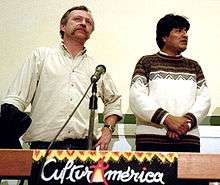
In August 2001, Banzer resigned due to terminal illness, and Jorge Quiroga took over as President.[67] Under U.S. pressure, Quiroga sought to have Morales expelled from Congress. To do so, he claimed that Morales' inflammatory language had caused the deaths of two police officers in Sacaba near Cochabamba, however was unable to provide any evidence of Morales' culpability. 140 deputies voted for Morales' expulsion, which came about in 2002. Morales asserted that it "was a trial against Aymara and Quechas", [68] while MAS activists interpreted it as evidence of the pseudo-democratic credentials of the political class.[69]
The MAS gained increasing popularity as a protest party, relying largely on widespread dissatisfaction with the existing mainstream political parties among Bolivians living in rural and poor urban areas.[70] Morales recognized this, and much of his discourse focused on differentiating the MAS from the traditional political class.[71] Their campaign was successful, and in the 2002 presidential election the MAS gained 20.94% of the national vote, becoming Bolivia's second largest party, being only 1.5% behind the victorious MNR, whose candidate, Gonzalo Sánchez de Lozada, became President.[72] They won 8 seats in the Senate and 27 in the Chamber of Deputies.[73] Now the leader of the political opposition, Morales focused on criticising government policies rather than outlining alternatives. He had several unconstructive meetings with Lozada, but met with Venezuela's Hugo Chávez for the first time.[74]
Bolivia's U.S. embassy had become publicly highly critical of Morales; just prior to the election, the U.S. ambassador to Bolivia Manuel Rocha issued a statement declaring that U.S. aid to Bolivia would be cut if MAS won the election. However, exit polls revealed that Rocha's comments had served to increase support for Morales.[75] Following the election, the U.S. embassy maintained this critical stance, characterising Morales as a criminal and encouraging Bolivia's traditional parties to sign a broad agreement to oppose the MAS; Morales himself began alleging that the U.S. Central Intelligence Agency was plotting to assassinate him.[76]
Rise to power: 2003–05
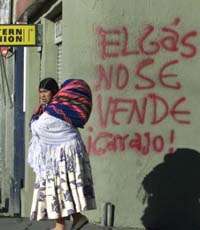
In 2003, the Bolivian gas conflict broke out as activists – including coca growers – protested against the privatization of the country's natural gas supply and its sale to U.S. companies below the market value. Activists blocked off the road into La Paz, resulting in clashes with police. 80 were killed and 411 injured, among them officers, activists, and civilians, including children.[77] Morales did not take an active role in the conflict, instead traveling to Libya and Switzerland, there describing the uprising as a "peaceful revolution in progress."[78] The government accused Morales and the MAS of using the protests to overthrow Bolivia's parliamentary democracy with the aid of organised crime, FARC, and the far left governments of Venezuela, Cuba and Libya.[79]
Morales led calls for President Sánchez de Lozada to step down over the death toll, gaining widespread support from the MAS, other activist groups, and the middle classes; with pressure building, Sánchez resigned and fled to Miami, Florida.[80] He was replaced by Carlos Mesa, who tried to strike a balance between U.S. and cocalero demands, but whom Morales mistrusted.[81] In November, Morales spent 24 hours with Cuban President Fidel Castro in Havana,[82] and then met Argentinian President Nestor Kirchner.[83] In the 2004 municipal election, the MAS became the country's largest national party, with 28.6% of all councilors in Bolivia. However, they had failed to win the mayoralty in any big cities, reflecting their inability to gain widespread support among the urban middle-classes.[84] In Bolivia's wealthy Santa Cruz region, a strong movement for autonomy had developed under the leadership of the Pro Santa Cruz Committee (Comite Pro Santa Cruz). Favorable to neoliberal economics and strongly critical of the cocaleros, they considered armed insurrection to secede from Bolivia should MAS take power.[85]
In March 2005, Mesa resigned, citing the pressure of Morales and the cocalero road blocks and riots.[86] Amid fears of civil war,[87] Eduardo Rodríguez became President of a transitional government, preparing Bolivia for a general election in December 2005.[88] Hiring the Peruvian Walter Chávez as its campaign manager, the MAS electoral campaign was based on Salvador Allende's successful campaign in the Chilean presidential election, 1970.[89] Measures were implemented to institutionalize the party structure, giving it greater independence from the social movement; this was done to allow Morales and other MAS leaders to respond quickly to new developments without the lengthy process of consulting the bases, and to present a more moderate image away from the bases' radicalism.[90] Although he had initially hoped for a female running mate, Morales eventually chose Marxist intellectual Álvaro García Linera as his Vice Presidential candidate,[91] with some Bolivian press speculating as to a romantic relationship between the two.[92] MAS' primary opponent was Jorge Quiroga and his center-right Social and Democratic Power, whose campaign was centered in Santa Cruz and which advocated continued neo-liberal reform; Quiroga accused Morales of promoting the legalization of cocaine and being a puppet for Venezuela.[93]
With a turnout of 84.5%, the election saw Morales gain 53.7% of the vote, while Quiroga came second with 28.6%; Morales' was the first victory with an absolute majority in Bolivia for 40 years.[94] Given that he was the sixth self-described leftist president to be elected in Latin America since 1998, his victory was identified as part of the broader regional pink tide.[95] Becoming president elect, Morales was widely described as Bolivia's first indigenous leader, at a time when around 62% of the population identified as indigenous; political analysts therefore drew comparisons with the election of Nelson Mandela to the South African Presidency in 1994.[96] This resulted in widespread excitement among the approximately 40 million indigenous people in the Americas, particularly those of Bolivia.[97] However, his election caused concern among the country's wealthy and landowning classes, who feared state expropriation and nationalisation of their property, as well as far-right groups, who claimed it would spark a race war.[97] He traveled to Cuba to spend time with Castro, before going to Venezuela, and then on tour to Europe, China and South Africa; he significantly avoided the U.S.[98] In January 2006, Morales attended an indigenous spiritual ceremony at Tiwanaku where he was crowned Apu Mallku (Supreme Leader) of the Aymara, receiving gifts from indigenous peoples across Latin America. He thanked the goddess Pachamama for his victory and proclaimed that "With the unity of the people, we're going to end the colonial state and the neo-liberal model."[99]
Presidency
First presidential term: 2006–09
In the world there are large and small countries, rich countries and poor countries, but we are equal in one thing, which is our right to dignity and sovereignty.
— Evo Morales, Inaugural Speech, 22 January 2006.[100]
Morales' inauguration took place on January 22 in La Paz. It was attended by various heads of state, including Kirchner, Chávez, Brazil's Lula da Silva, and Chile's Ricardo Lagos.[101] Morales wore an Andeanized suit designed by fashion designer Beatriz Canedo Patiño,[102] and gave a speech that included a minute silence in memory of cocaleros and indigenous activists killed in the struggle.[101] He condemned Bolivia's former "colonial" regimes, likening them to South Africa under apartheid and stating that the MAS' election would lead to a "refoundation" of the country, a term that the MAS consistently used over "revolution".[103] Morales repeated these views in his convocation of the Constituent Assembly.[104]
In taking office, Morales emphasized nationalism, anti-imperialism, and anti-neoliberalism, although did not initially refer to his administration as socialist.[105] In what was widely termed a populist act, he immediately reduced both his own presidential wage and that of his ministers by 57% to $1,875 a month, also urging members of Congress to do the same.[106][107][108] Morales gathered together a largely inexperienced cabinet made up of indigenous activists and leftist intellectuals,[109] although over the first three years of government there was a rapid turnover in the cabinet as Morales replaced many of the indigenous members with trained middle-class leftist politicians.[110] By 2012 only 3 of the 20 cabinet members identified as indigenous.[111]
Economic program
Upon his election to the presidency, Bolivia was South America's poorest nation.[112] Morales' government did not initiate any fundamental change in Bolivia's economic structure,[113] and in their National Development Plan (PDN) for 2006–10, they adhered largely to the country's previous liberal economic model.[114] Bolivia's economy was based largely on the extraction of natural resources, with the nation having South America's second largest reserves of natural gas.[115] As per his election pledge, Morales took increasing state control of this hydrocarbon industry with Supreme Decree 2870; previously, corporations paid 18% of their profits to the state, but Morales symbolically reversed this, so that 82% of profits went to the state and 18% to the companies. The oil companies threatened to take the case to the international courts or cease operating in Bolivia, but ultimately relented. Thus, where Bolivia had received $173 million from hydrocarbon extraction in 2002, by 2006 they received $1.3 billion.[116] Although not technically a form of nationalization, Morales and his government referred to it as such, resulting in criticism from sectors of the Bolivian left.[117] However, in June 2006, Morales announced his desire to nationalize mining, electricity, telephones, and railroads, and in February 2007 nationalized the Vinto metallurgy plant, refusing to compensate Glencore, whom the government asserted had obtained the contract illegally.[118] Although the FSTMB miners' federation called for the government to nationalise the mines, the government did not do so, instead stating that any transnational corporations operating in Bolivia legally would not be expropriated.[119]
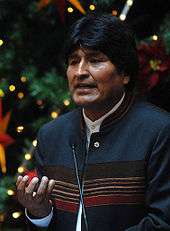
Under Morales, Bolivia experienced unprecedented macroeconomic strength, resulting in the increase in value of its currency, the boliviano.[120] His first year in office ended with no fiscal deficit; the first time this had happened in Bolivia for 30 years,[121] while during the global financial crisis of 2007–08 it maintained some of the world's highest levels of economic growth.[122] Such economic strength led to a nationwide boom in construction,[120] and allowed the state to both build up strong financial reserves.[120] Although the levels of social spending were increased, they remained relatively conservative, with a major priority being placed on constructing paved roads, as well as community spaces such as soccer fields and union buildings.[123] In particular, the government focused on rural infrastructure improvement, to bring roads, running water, and electricity to areas that lacked them.[124]
Their stated intention was to reduce Bolivia's most acute poverty levels from 35% to 27% of the population, and moderate poverty levels from 58.9% to 49% over five years.[125] Welfare provision was expanded, as characterized by the introduction of non-contributory old-age pensions and payments to mothers provided their babies are taken for health checks and that their children attend school. Hundreds of free tractors were also handed out. The prices of gas and many foodstuffs were controlled, and local food producers were made to sell in the local market rather than export. A new state-owned body was also set up to distribute food at subsidized prices. All these measures helped to curb inflation, while the economy (partly because of rising public spending) grew strongly, accompanied by stronger public finances which brought economic stability.[126]
During Morales' first term, Bolivia broke free of the domination of the World Bank and International Monetary Fund (IMF) which had characterised previous regimes by refusing their financial aid and connected regulations.[127] In May 2007, it became the world's first country to withdraw from the International Center for the Settlement of Investment Disputes, with Morales asserting that the institution had consistently favored multinational corporations in its judgments; Bolivia's lead was followed by other Latin American nations.[128] Despite being encouraged to do so by the U.S., Bolivia refused to join the Free Trade Area of the Americas, deeming it a form of U.S. imperialism.[129] In December 2015 a new Bolivian partnership with the World Bank, with which establishes medium term objectives to eradicate extreme poverty and translate growth into well-being.[130]
A major dilemma faced by Morales' administration was between the desire to expand extractive industries in order to fund social programs and provide employment, and to protect the country's environment from the pollution caused by those industries.[131] Although his government professed an environmentalist ethos, expanding environmental monitoring and becoming a leader in the voluntary Forest Stewardship Council, Bolivia continued to witness rapid deforestation for agriculture and illegal logging.[132] Economists on both the left and right expressed concern over the government's lack of economic diversification.[122] Many Bolivians opined that Morales' government had failed to bring about sufficient job creation.[113]
ALBA and international appearances
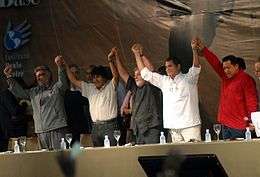
Morales' administration sought to build strong links with the hard left governments of Cuba and Venezuela.[133] In April 2005 Morales traveled to Havana for knee surgery, there meeting with the two nations' presidents, Castro and Chávez.[134] In April 2006, Bolivia agreed to join Cuba and Venezuela in founding the Bolivarian Alternative for the Americas (ALBA), with Morales attending ALBA's conference in May, at which they initiated with a Peoples' Trade Agreement (PTA).[135] Meanwhile, his administration became "the least US-friendly government in Bolivian history".[136] In September Morales visited the U.S. for the first time to attend the UN General Assembly, where he gave a speech condemning U.S. President George W. Bush as a terrorist for launching the War in Afghanistan and Iraq War, and called for the UN Headquarters to be moved out of the country. In the U.S., he met with former presidents Bill Clinton and Jimmy Carter and with Native American groups.[137] Relations were further strained between the two nations when in December Morales issued a Supreme Decree requiring all U.S. citizens visiting Bolivia to have a compulsory visa.[138] His government also refused to grant legal immunity to U.S. soldiers in Bolivia; hence the U.S. cut back their military support to the country by 96%.[129]
In December 2006, he attended the first South-South conference in Abuja, Nigeria, there meeting Libyan leader Muammar Gaddafi, whose government had recently awarded Morales the Al-Gaddafi International Prize for Human Rights.[139] Morales proceeded straight to Havana for a conference celebrating Castro's life, where he gave a speech arguing for stronger links between Latin America and the Middle East to combat U.S. imperialism.[140] Under his administration, diplomatic relations were established with Iran, with Morales praising Iranian President Mahmoud Ahmadinejad as a revolutionary comrade.[141] In April 2007 he attended the first South American Energy Summit in Venezuela, arguing with many allies over the issue of biofuel, which he opposed.[142] He had a particularly fierce argument with Brazilian President Lula over Morales' desire to bring Bolivia's refineries – which were largely owned by Brazil's Petrobrás – under state control. In May, Bolivia purchased the refineries and transferred them to the Bolivian State Petroleum Company (YPFB).[143]
Social reform
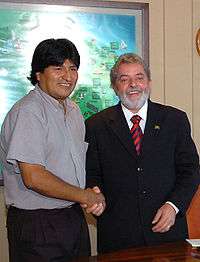
Morales' government sought to encourage a model of development based upon the premise of vivir bien, or "living well".[112] This entailed seeking social harmony, consensus, the elimination of discrimination, and wealth redistribution; in doing so, it was rooted in communal rather than individual values and owed more to indigenous Andean forms of social organization than Western ones.[112]
Upon Morales' election, Bolivia's illiteracy rate was at 16%, the highest in South America.[144] Attempting to rectify this with the aid of far left allies, Bolivia launched a literacy campaign with Cuban assistance, while Venezuela invited 5000 Bolivian high school graduates to study in Venezuela for free.[145]
By 2009, UNESCO declared Bolivia free from illiteracy,[146] although the World Bank claimed that it had only declined by 5%.[147] Cuba also aided Bolivia in the development of its medical care, opening ophthalmological centres in the country to treat 100,000 Bolivians for free per year, and offering 5000 free scholarships for Bolivian students to study medicine in Cuba.[148] The government sought to expand state medical facilities, opening twenty hospitals by 2014, and increasing basic medical coverage up to the age of 25.[149] Their approach sought to utilise and harmonise both mainstream Western medicine and Bolivia's traditional medicine.[150]
The 2006 Bono Juancito Pinto program provided US$29 per month to poor families for every young child that they had,[151] while 2008's Renta Dignidad initiative provided around $344 per month to low-income citizens over 60.[152] 2009's Bono Juana Azurduy program offered cash transfers to uninsured mothers to improve their likelihood of seeking medical care.[153] Conservative critics of Morales' regime claimed that these measures were simply designed to buy off the poor and ensure continued support for the government.[154]
Morales announced that one of the top priorities of his government was to eliminate racism against the country's indigenous population.[155] To do this, he announced that all civil servants were required to learn one of Bolivia's three indigenous languages, Quechua, Aymara, or Guaraní, within two years.[156] His government encouraged the development of indigenous cultural projects,[157] and sought to encourage more indigenous people to attend university; by 2008, it was estimated that half of the students enrolled in Bolivia's 11 public universities were indigenous,[158] while three indigenous-specific universities had been established, offering subsidized education.[159] In 2009, a Vice Ministry for Decolonization was established, which proceeded to pass the 2010 Law against Racism and Discrimination banning the espousal of racist views in private or public institutions.[160] Various commentators noted that there was a renewed sense of pride among the country's indigenous population following Morales' election.[161] Conversely, the opposition accused Morales' administration of aggravating racial tensions between indigenous, white, and mestizo populations,[162] with some non-indigenous Bolivians feeling that they were now experiencing racism.[163]
On International Workers' Day 2006, Morales issued a presidential decree undoing aspects of the informalization of labor which had been implemented by previous neoliberal governments; this was seen as a highly symbolic act for labor rights in Bolivia.[164] In 2009 his government put forward suggested reforms to the 1939 labor laws, although lengthy discussions with trade unions hampered the reforms' progress.[165] Morales' government increased the legal minimum wage by 50%,[166] and reduced the pension age from 65 to 60, and then in 2010 reduced it again to 58.[167]
While policies were brought in to improve the living conditions of the working classes, conversely many middle-class Bolivians felt that they had seen their social standing decline,[168] with Morales personally mistrusting the middle-classes, deeming them fickle.[169] A 2006 law reallocated state-owned lands,[170] with this agrarian reform entailing distributing land to traditional communities rather than individuals.[171] In 2010, a law was introduced permitting the formation of recognised indigenous territories, although the implementation of this was hampered by bureaucracy and contesting claims over ownership.[172] Morales' regime also sought to improve women's rights in Bolivia.[173] In 2010, it founded a Unit of Depatriarchalization to oversee this process.[110] Further seeking to provide legal recognition and support to LGBT rights, it declared June 28 to be Sexual Minority Rights Day in the country,[174] and encouraged the establishment of a gay-themed television show on the state channel.[175]
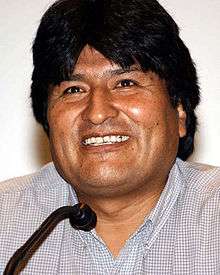
Adopting a policy known as "Coca Yes, Cocaine No",[176] Morales' administration ensured the legality of coca growing, but also introduced measures to regulate the production and trade of the crop.[177] In 2007, they announced that they would permit the growing of 50,000 acres of coca in the country, primarily for the purposes of domestic consumption,[178] with each family being restricted to the growing of one cato (1600 metres squared) of coca.[179]
A social control program was implemented whereby local unions took on responsibility for ensuring that this quota was not exceeded; in doing so, they hoped to remove the need for military and police intervention, and thus stem the violence of previous decades.[180] Measures were implemented to ensure the industrialization of coca production, with Morales inaugurating the first coca industrialization plant in Chulumani, which produced and packaged coca and trimate tea; the project was primarily funded through a $125,000 donation from Venezuela under the PTA scheme.[177]
However, these industrialization measures proved largely unsuccessful given that coca remained illegal in most nations outside Bolivia, thus depriving the growers of an international market.[181] Campaigning against this, in 2012 Bolivia withdrew from the UN 1961 Convention which had called for global criminalisation of coca, and in 2013 successfully convinced the UN Single Convention on Narcotic Drugs to declassify coca as a narcotic.[182] The U.S. State Department criticised Bolivia, asserting that it was regressing in its counter-narcotics efforts, and dramatically reduced aid to Bolivia to $34 million to fight the narcotics trade in 2007.[183] Nevertheless, the number of cocaine seizures in Bolivia increased under Morales' government,[184] as they sought to encourage coca growers to report and oppose cocaine producers and traffickers.[185] However, high levels of police corruption surrounding the illicit trade in cocaine remained a continuing problem for Bolivia.[186]
Morales' government also introduced measures to tackle Bolivia's endemic corruption; in 2007, he used a presidential decree to create the Ministry of Institutional Transparency and Fight Against Corruption.[187] However, critics highlighted that MAS members were rarely prosecuted for the crime, the main exception being YPFB head Santos Ramírez, who was sentenced to twelve years imprisonment for corruption in 2008. Conversely, a 2009 law that permitted the retroactive prosecution for corruption led to legal cases being brought against a number of opposition politicians for alleged corruption in the pre-Morales period; many fled abroad to avoid standing trial.[188]
Domestic unrest and the new constitution
During his presidential campaign, Morales had supported calls for regional autonomy for Bolivia's departments. As president, he changed his position, viewing the calls for autonomy – which came from Bolivia's four eastern departments of Santa Cruz, Beni, Pando, and Tarija – as an attempt by the wealthy bourgeoisie living in these regions to preserve their economic position.[189] He nevertheless agreed to a referendum on regional autonomy, held in July 2006; the four eastern departments voted in favor of autonomy, but Bolivia as a whole voted against it by 57.6%.[190] In September, autonomy activists launched strikes and blockades across eastern Bolivia, resulting in violent clashes with MAS activists.[191] In January 2007, clashes in Cochabamba between activist groups led to fatalities, with Morales' government sending in troops to maintain the peace. The left-indigenous activists formed a Revolutionary Departmental Government, but Morales denounced it as illegal and continued to recognise the legitimacy of right-wing departmental head Manfred Reyes Villa.[192]
In July 2006, an election to form a Constitutional Assembly was held, which saw the highest ever electoral turnout in the nation's history. MAS won 137 of its 255 seats, after which the Assembly was inaugurated in August.[193] In November, the Assembly approved a new constitution, which converted the Republic of Bolivia into the Plurinational State of Bolivia, describing it as a "plurinational communal and social unified state". The constitution emphasized Bolivian sovereignty of natural resources, separated church and state, forbade foreign military bases in the country, implemented a two-term limit for the presidency, and permitted limited regional autonomy. It also enshrined every Bolivians' right to water, food, free health care, education, and housing.[194] In enshrining the concept of plurinationalism, one commentator noted that it suggested "a profound reconfiguration of the state itself" by recognising the rights to self-determination of various nations within a single state.[195]
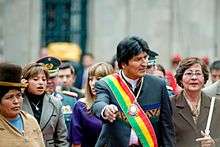
In May 2008, the eastern departments pushed for greater autonomy, but Morales' government rejected the legitimacy of their position.[196] They called for a referendum on recalling Morales, which saw an 83% turnout and in which Morales was ratified with 67.4% of the vote.[197] Unified as the National Council for Democracy (CONALDE), these groups – financed by the wealthy agro-industrialist, petroleum, and financial elite – embarked on a series of destabilisation campaigns to unseat Morales' government.[198] Unrest then broke out across eastern Bolivia, as radicalized autonomist activists established blockades, occupied airports, clashing with pro-government demonstrations, police, and armed forces. Some formed paramilitaries, bombing state companies, indigenous NGOs, and human rights organisations, also launching armed racist attacks on indigenous communities, culminating in the Pando Massacre of MAS activists.[199] The autonomists gained support from some high-ranking politicians; Santa Cruz Governor Rubén Costas lambasted Morales and his supporters with racist epithets, accusing the president of being an Aymara fundamentalist and a totalitarian dictator responsible for state terrorism.[200] Amid the unrest, foreign commentators began speculating on the possibility of civil war.[201]
After it was revealed that USAID's Office of Transition Initiatives had supplied $4.5 million to the pro-autonomist departmental governments of the eastern provinces, in September 2008 Morales accused the U.S. ambassador to Bolivia, Philip Goldberg, of "conspiring against democracy" and encouraging the civil unrest, ordering him to leave the country.[202][203] The U.S. government responded by expelling Bolivian ambassador to the U.S., Gustavo Guzman.[204] Bolivia subsequently expelled the U.S. Drug Enforcement Administration (DEA) from the country, while the U.S. responded by withdrawing their Peace Corps.[205] Chávez stood in solidarity with Bolivia by ordering the U.S. ambassador Patrick Duddy out of his country and withdrawing the Venezuelan ambassador to the U.S.[206] The Union of South American Nations (UNASUR) convened a special meeting to discuss the Bolivian situation, expressing full support for Morales' government.[207]

Although unable to quell the autonomist violence, Morales' government refused to declare a state of emergency, believing that the autonomists were attempting to provoke them into doing so.[208] Instead, they decided to compromise, entering into talks with the parliamentary opposition. As a result, 100 of the 411 elements of the Constitution were changed, with both sides compromising on certain issues.[209] Nevertheless, the governors of the eastern provinces rejected the changes, believing it gave them insufficient autonomy, while various Indianist and leftist members of MAS felt that the amendments conceded too much to the political right.[210] The constitution was put to a referendum in January 2009, in which it was approved by 61.4% of voters.[211]
Following the approval of the new Constitution, the 2009 general election was called. The opposition sought to delay the election by demanding a new biometric registry system, hoping that it would give them time to form a united front against MAS.[212] Many MAS activists reacted violently against the demands, and attempting to prevent this. Morales went on a five-day hunger strike in April 2009 to push the opposition to rescind their demands. He also agreed to allow for the introduction of a new voter registry, but insisted that it was rushed through so as not to delay the election.[213] Morales and the MAS won with a landslide majority, polling 64.2%, while voter participation had reached an all-time high of 90%.[214] His primary opponent, Reyes Villa, gained 27% of the vote. The MAS won a two-thirds majority in both the Chamber of Deputies and the Senate.[215] Morales notably increased his support in the east of the country, with MAS gaining a majority in Tarija.[216] In response to his victory, Morales proclaimed that he was "obligated to accelerate the pace of change and deepen socialism" in Bolivia, seeing his re-election as a mandate to further his reforms.[217]
Second presidential term: 2009–14
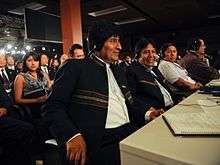
During his second term, Morales began to speak openly of "communitarian socialism" as the ideology that he desired for Bolivia's future.[218] He assembled a new cabinet which was 50% female, a first for Bolivia,[219] although by 2012, that had dropped to a third.[173] In April 2010, the departmental elections saw further gains for MAS.[220] In 2013, the government passed a law to combat domestic violence against women.[221]
In December 2009, Morales attended the 2009 United Nations Climate Change Conference in Copenhagen, Denmark, where he blamed climate change on capitalism and called for a financial transactions tax to fund climate change mitigation. Ultimately deeming the conference to have been a failure, he oversaw the World's People Conference on Climate Change and the Rights of Mother Earth outside of Cochabamba in April 2010.[222]
Following the victories of Barack Obama and the Democratic Party in the 2008 U.S. presidential election, relations between Bolivia and the U.S. improved slightly, and in November 2009 the countries entered negotiations to restore diplomatic relations.[223] After the U.S. backed the 2011 military intervention in Libya by NATO forces, Morales condemned Obama, calling for his Nobel Peace Prize to be revoked.[224] The two nations restored diplomatic relations in November 2011,[225] although Morales refused to allow the DEA back into the country.[226]
In October 2012, the government passed a Law of Mother Earth that banned genetically modified organisms (GMOs) being grown in Bolivia; although praised by environmentalists, it was criticised by the nation's soya growers, who claimed that it would make them less competitive on the global market.[227]
On 2 July 2013, Bolivia's foreign minister said that the diversion of Morales's presidential plane (FAB-001, a Dassault Falcon 900EX), when Portuguese, French, Spanish and Italian authorities denied access to their airspace due to suspicions that Edward Snowden was on board the aircraft, had put the president's life at risk.[228] Latin American leaders describe the incident as a "stunning violation of national sovereignty and disrespect for the region".[229] Morales himself described the incident as a "hostage" situation.[230] France apologized for the incident the next day.[231] The presidents of Argentina, Ecuador, Suriname, Uruguay and Venezuela, Morales's political allies in the region, gathered to demand an explanation of the incident.[232]
In 2014, Morales became the oldest active professional soccer player in the world after signing a contract for 200 dollars a month with Sport Boys Warnes.[233]
On 31 July 2014, Morales condemned the 2014 Israel–Gaza conflict and declared Israel a "terrorist state".[234]
Domestic protests
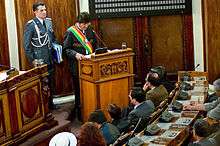
Morales' second term was heavily affected by infighting and dissent from within his own support base, as indigenous and leftist activists came to oppose a number of the governments' reforms.[235] In May 2010, Morales' government announced a 5% rise in the minimum wage. The Bolivian Workers' Central (COB) felt this insufficient given the rise in the cost of living, and called a general strike. Protesters clashed with police, although the government refused to increase the rise, accusing protesters of being pawns of the right.[236] In August 2010, violent protests then broke out in southern Potosí over widespread unemployment and a lack of investment in infrastructure.[221]
In December 2010, the government decreed it would cut government subsidies for gasoline and diesel fuels, which had proved to be a major area of social spending; this resulted in higher fuel prices and transport costs. Protests broke out across the country, and Morales soon agreed to nullify the decree, stating that he "ruled by obeying".[237]
The following year, the government announced plans to construct a highway connecting Beni to Cochabamba, in order to better integrate the isolated departments of Beni and Pando with the rest of the country and to facilitate hydrocarbons exploration. The highway however would go straight through the Isiboro Sécure National Park and Indigenous Territory (TIPNIS), and thus came under staunch criticism from environmentalists and members of the indigenous communities living in the park, who believed that it would encourage illegal settlement and deforestation and that it further violated both the constitution and United Nations Declaration on the Rights of Indigenous Peoples.
In August 2011, 800 protesters embarked on a protest march from Trinidad to La Paz, on the way facing violent conflict from police and those who supported the road, with many being injured. The controversy caused two government officials and various other high-ranking officials to resign in protest, while Morales begged forgiveness but blamed the U.S. and Bolivia's right-wing for stirring up the unrest. In October 2011, he passed Law 180, prohibiting further road construction, although the government proceeded with a consultation, eventually gaining the consent of 55 of the 65 communities in TIPNIS to allow the highway to be built, albeit with a variety of concessions; construction was scheduled to take place after the 2014 general election.[238][239][240] In May 2013, the government then announced that it would permit hydrocarbon exploration in the nation's 22 national parks, to widespread condemnation from environmentalists.[227]
Further protests broke out in June 2012, this time from the Bolivian police, who objected to government reforms designed to combat widespread corruption in the force. Police broke into their own offices to burn all disciplinary case records, and demanded salary increases. Morales' government relented, cancelling many of the proposed reforms and agreeing to the salary increase.[241]
Third presidential term: 2014–present
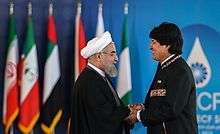
In 2008, Morales had vowed that he would not stand for re-election in the 2014 general election.[242] However, he successfully did so and after proclaiming victory in the election, Morales declared it "a triumph of the anti-colonialists and anti-imperialists" and dedicated his win to both Castro and Chávez.[243][244][245]
On the basis of this victory, the Financial Times remarked that Morales represented "one of the world's most popular leaders".[246] On 17 October 2015, Morales surpassed Andrés de Santa Cruz's nine years, eight months, and twenty-four days in office and became Bolivia's longest serving president.[247][248] Writing in The Guardian, Ellie Mae O'Hagan attributes his enduring popularity not to anti-imperialist rhetoric but his "extraordinary socio-economic reforms," which resulted in poverty and extreme poverty declining by 25% and 43% respectively.[249]
In early February 2016 there were rumors that Morales had had a child by a young woman, Gabriela Zapata Montaño, and had granted favors to the Chinese company for which she worked. Morales admitted that they had had a son (who had died in infancy), but denied vehemently any granting of favors and said he had not been in contact with Zapata Montaño since 2007.[250]
On 21 February 2016, a referendum was held on the question of whether Morales should be allowed to run for a fourth term when his third term would expire in 2020 which he narrowly lost.[251] His approval rating had been damaged by the allegations concerning his relationship with Gabriela Zapata Montaño.[252]
Political ideology
The worst enemy of humanity is capitalism. That is what provokes uprisings like our own, a rebellion against a system, against a neo-liberal model, which is the representation of a savage capitalism. If the entire world doesn't acknowledge this reality, that the national states are not providing even minimally for health, education and nourishment, then each day the most fundamental human rights are being violated.
– Evo Morales[253]
Figures in the Morales government have described the President's approach to politics as "Evoism" or "Evismo".[254] From 2009, Morales has advocated "communitarian socialism",[218] while political scientist Sven Harten characterized Morales's ideology as "eclectic", drawing ideas from "various ideological currents".[255] Harten noted that whilst Morales uses fierce anti-imperialist and leftist rhetoric, he is neither "a hardcore anti-globalist nor a Marxist," not having argued for the violent and absolute overthrow of capitalism or U.S. involvement in Latin America.[256]
Economically, Morales' policies have sometimes been termed "Evonomics" and have focused on creating a mixed economy.[257] Morales' presidential discourse has revolved around distinguishing between "the people", of whom he sees himself as a representative, and the oppressive socio-economic elite and the old political class, whom he believes have mistreated "the people" for centuries.[258] Morales sought to make Bolivia's representative democracy more direct and communitarian, through the introduction of referendums and a citizen-led legislative initiative.[259] George Philip and Francisco Panizza claimed that like his allies Correa and Chávez, Morales should be categorized as a populist,[260] because he appealed "directly to the people against their countries' political and economic order, divided the social field into antagonistic camps and promised redistribution and recognition in a newly founded political order."[261]
Various far left commentators have argued against categorizing the Morales administration as socialist. Bolivia's Marxist Vice President Álvaro García Linera asserts that Bolivia lacks the sufficiently large industrialized working class, or proletariat, to enable it to convert into a socialist society in the Marxist understanding of the word. Instead, he terms the government's approach "Andean and Amazonian capitalism".[262] Marxist American sociologist James Petras has argued that Morales' government is neither socialist nor anti-imperialist, instead describing Morales as a "radical conservative" for utilizing socialist rhetoric while continuing to support foreign investment and the economic status of Bolivia's capitalist class,[263] while British Trotskyite academic Jeffery R. Webber asserted that Morales was no socialist but that his regime was "reconstituting neoliberalism", thereby rejecting "neoliberal orthdoxy" but retaining a "core faith in the capitalist market as the principal engine of growth and industrialization."[264] Similarly, Aymara activist Felipe Quispe characterised Morales' government as "neoliberalism with an Indian [i.e. indigenous] face".[265]
Personal life
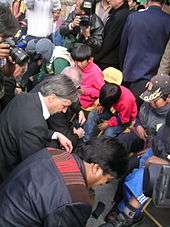
Morales identifies as ethnically Aymara, and has been widely described as Bolivia's first democratically-elected President from the indigenous majority.[5] Although Morales has sometimes been described as the first indigenous president to be democratically elected in Latin America, this description in fact goes to Benito Juárez, a Mexican of the Zapotec ethnic group, who was elected President of Mexico in 1858.[6] Biographer Martín Sivak described Morales as "incorruptible, charismatic, and combative",[266] also noting that he had a "friendly style" and could develop a good rapport with journalists and photographers, in part because he could "articulate his opinions with simplicity".[44] He places a great emphasis on trust,[267] and relies on his intuition, sometimes acting on what he considers omens in his dreams.[268] Harten noted that Morales "can be a forceful leader, one who instills great respect and, sometimes, a reluctance in others to contradict him, but he has also learnt to listen and learn from other people."[269] Farthing and Kohl characterised Morales as a "charismatic populist" of a kind common in Latin American history, who prioritized "a direct relationship" between the population and the leader.[270]
Morales is not married and upon becoming president selected his older sister, Esther Morales Ayma, to adopt the role of First Lady. He has three children from different mothers. They are Eva Liz Morales Alvarado (born 1994), Álvaro Morales Paredes (born 1995), and Ernesto Fidel Morales Zapata (born 2007 and allegedly[271] died in infancy).[272][273][274] Politician Juan del Granado is Eva Liz's godfather.[272] Morales' romantic relationship with Ernesto's mother Gabriela Zapata Montaño, from 2005 to 2007, remained unknown publicly until 2016.[275]
Morales has commented that he is only a Roman Catholic in order "to go to weddings", and when asked if he believed in God, responded that "I believe in the land. In my father and my mother. And in Cuchi-Cuchi."[276] [277]
Morales is also an association football enthusiast and plays the game frequently, often with local teams.[278][279]
Morales's unorthodox behavior contrasts with the usual manners of dignitaries and other political leaders in Latin America. During speeches he made use of personal stories and anecdotes,[280] and used coca as "a potent political symbol", wearing a coca leaf garland around his neck and a hat with coca leaves in it when speaking to crowds of supporters.[281] Following his election, he wore striped jumpers rather than the suits typically worn by politicians. It became a symbol of Morales, with copies of it selling widely in Bolivia.[282][283] [269]
Influence and legacy
Morales has been described as "the most famous Bolivian ever",[4] whose personality has become "fixed in the global imagination".[284] Morales' government has been seen as part of the pink tide of left-leaning Latin American governments, becoming particularly associated with the hard left current of Venezuela and Cuba.[285] It has been widely praised for its pro-socialist stance among the international left,[220] who have taken an interest in Bolivia under his leadership as a "political laboratory"[286] or "a living workshop" for the development of an alternative to capitalism.[287] Domestically, Morales' support base has been among Bolivia's poor and indigenous communities.[5] For these communities, who have widely felt marginalized in Bolivian politics for decades, Morales "invokes a sense of dignity and destiny" in a way that no other contemporary politician has done.[288] He has received the support of many democratic socialists and social democrats, as well as sectors of Bolivia's liberal movement, who have been critical of Morales but favoured him over the right-wing opposition.[289]
Opposition to Morales' governance has centered in the wealthy eastern lowland province of Santa Cruz.[5] His policies often antagonized middle-class Bolivians, who deemed them too radical and argued that they threatened private property.[5] Morales' discourse of "the people" against the socio-economic elites has brought a spotlight on the deep social polarization in Bolivia.[290] His most vociferous critics have been from Bolivia's conservative movement, although he has also received criticism from the country's far left, who believe his reformist policies have been insufficiently radical or socialist.[289]
Critics, particularly in the U.S. government, have varyingly termed him "a left-wing radical, a partner of narco-traffickers and a terrorist".[291] His regime has also faced many of the same complaints directed at previous Bolivian administrations, revolving around such issues as "concentration of power, corruption, incompetent bureaucracies, and disrespect for civil liberties".[292]
See also
- Domestic policy of Evo Morales
- Foreign policy of Evo Morales
- Evo Morales and the Roman Catholic Church
- Pink tide
References
Notes
- ↑ Morales is described as the first indigenous president of Bolivia in academic studies of his presidency, such as those of Muñoz-Pogossian,[1] Webber,[2] Philip and Panizza,[3] and Farthing and Kohl,[4] as well as in press reports, such as those of BBC News.[5] However, there have been challenges to this claim by critics who have asserted that Morales probably has some European ancestry, and thus on genetic grounds is technically mestizo rather than solely indigenous.[6] Harten asserted that this argument was "misguided[,] wrong[... and] above all irrelevant" because regardless of his genetic makeup, the majority of Bolivians perceive Morales as being the first indigenous president.[6] In Bolivian society, indigeneity is a fluid concept rooted in cultural identity;[6] for instance, many indigenous individuals that have settled in urban areas and abandoned their traditional rural customs have come to identify as mestizo.[7]
Footnotes
- ↑ Muñoz-Pogossian 2008, p. 180.
- ↑ Webber 2011, p. 1.
- ↑ Philip & Panizza 2011, p. 57.
- 1 2 Farthing & Kohl 2014, p. 1.
- 1 2 3 4 5 6 "Profile: Bolivia's President Evo Morales". BBC News. 13 October 2014.
- 1 2 3 4 Harten 2011, p. 7.
- ↑ Farthing & Kohl 2014, p. 22.
- 1 2 3 Harten 2011, p. 35.
- ↑ Harten 2011, p. 35; Webber 2011, p. 62.
- ↑ Gutsch 2006; Sivak 2010, p. 32; Harten 2011, p. 35.
- ↑ Sivak 2010, p. 33.
- ↑ Sivak 2010, p. 33; Harten 2011, p. 7; Webber 2011, p. 63.
- ↑ Sivak 2010, p. 32; Harten 2011, p. 35.
- ↑ Sivak 2010, pp. 33–34; Harten 2011, p. 36.
- ↑ Sivak 2010, p. 34; Harten 2011, p. 36; Webber 2011, pp. 62–63.
- ↑ Sivak 2010, p. 33; Harten 2011, pp. 36–37.
- ↑ Sivak 2010, p. 34; Harten 2011, p. 40.
- 1 2 Harten 2011, p. 37.
- ↑ Sivak 2010, pp. 34–35; Harten 2011, p. 37; Webber 2011, p. 63.
- ↑ Sivak 2010, p. 35; Harten 2011, p. 37.
- ↑ Blackwell 2002; Sivak 2010, p. 35; Harten 2011, p. 37.
- ↑ Harten 2011, pp. 37–38.
- ↑ Sivak 2010, p. 35.
- ↑ Sivak 2010, p. 36; Harten 2011, p. 39.
- ↑ Webber 2011, p. 63.
- 1 2 3 Sivak 2010, p. 39.
- ↑ Harten 2011, p. 39.
- ↑ Sivak 2010, pp. 40–41.
- ↑ Sivak 2010, pp. 40–41; Philip & Panizza 2011, pp. 76–77.
- 1 2 3 4 5 Sivak 2010, p. 42.
- ↑ Sivak 2010, pp. 40–41, 57–58.
- ↑ Sivak 2010, p. 41.
- ↑ Harten 2011, p. 109.
- ↑ Sivak 2010, p. 42; Harten 2011, p. 109.
- 1 2 Sivak 2010, p. 43.
- ↑ Sivak 2010, pp. 43, 65.
- ↑ Sivak 2010, pp. 43–44, 49.
- ↑ Sivak 2010, p. 52.
- ↑ Sivak 2010, p. 58.
- 1 2 3 Harten 2011, pp. 74–77.
- ↑ Sivak 2010, p. 44.
- ↑ Harten 2011, pp. 97–99.
- ↑ Sivak 2010, pp. 44–45.
- 1 2 Sivak 2010, p. 45.
- ↑ Sivak 2010, pp. 45–47.
- ↑ Sivak 2010, p. 47.
- ↑ Sivak 2010, pp. 47–49.
- ↑ Harten 2011, p. 83.
- 1 2 3 4 Harten 2011, p. 84.
- ↑ Harten 2011, p. 84; Webber 2011, p. 60.
- 1 2 Sivak 2010, p. 79.
- ↑ Muñoz-Pogossian 2008, p. 24; Sivak 2010, p. 79; Harten 2011, p. 84; Webber 2011, p. 60.
- 1 2 Harten 2011, p. 85.
- ↑ Sivak 2010, pp. 79–80.
- ↑ Harten 2011, p. 85; Webber 2011, p. 60.
- ↑ Harten 2011, p. 86.
- ↑ Sivak 2010, p. 81.
- ↑ Sivak 2010, pp. 81–82.
- 1 2 Harten 2011, p. 86; Webber 2011, p. 60.
- ↑ America Vera-Zavala (December 18, 2005). "Evo Morales Has Plans for Bolivia". In These Times. Archived from the original on March 3, 2015. Retrieved February 7, 2007.
- ↑ Sivak 2010, pp. 89–90; Harten 2011, p. 87.
- ↑ Harten 2011, pp. 89–90.
- ↑ Sivak 2010, p. 82–83; Harten 2011, pp. 112–118; Farthing & Kohl 2014, p. 11.
- ↑ Harten 2011, pp. 107, 117.
- ↑ Sivak 2010, pp. 83–84.
- ↑ Harten 2011, p. 126.
- ↑ Sivak 2010, p. 84.
- ↑ Sivak 2010, pp. 84–85.
- ↑ Harten 2011, p. 117.
- ↑ Harten 2011, pp. 95–96.
- ↑ Harten 2011, p. 102.
- ↑ Muñoz-Pogossian 2008, p. 149; Sivak 2010, p. 90; Harten 2011, p. 87; Webber 2011, p. 63; Farthing & Kohl 2014, pp. 11–12.
- ↑ Harten 2011, p. 87.
- ↑ Sivak 2010, pp. 94-96.
- ↑ Sivak 2010, p. 86–87; Sivak 2011, p. 158; Harten 2011, p. 87.
- ↑ Sivak 2010, pp. 95, 98; Sivak 2011, p. 159.
- ↑ Muñoz-Pogossian 2008, pp. 164–167; Sivak 2010, pp. 99–103; Harten 2011, pp. 118–124.
- ↑ Sivak 2010, p. 100.
- ↑ Harten 2011, pp. 122–123.
- ↑ Muñoz-Pogossian 2008, p. 167; Sivak 2010, pp. 101–103; Harten 2011, pp. 122–124.
- ↑ Muñoz-Pogossian 2008, p. 167; Sivak 2010, pp. 137–139; Webber 2011, p. 80.
- ↑ Sivak 2010, pp. 103–104.
- ↑ Sivak 2010, p. 138.
- ↑ Sivak 2010, p. 142; Harten 2011, p. 88.
- ↑ Sivak 2010, pp. 141–142.
- ↑ Muñoz-Pogossian 2008, p. 175; Sivak 2010, pp. 142–145; Farthing & Kohl 2014, p. 14.
- ↑ Sivak 2010, p. 146.
- ↑ Muñoz-Pogossian 2008, p. 175; Sivak 2010, p. 147.
- ↑ Sivak 2010, pp. 148–149.
- ↑ Harten 2011, pp. 140, 151; Webber 2011, p. 68.
- ↑ Muñoz-Pogossian 2008, pp. 179–180; Sivak 2010, pp. 150–151; Harten 2011, p. 88; Webber 2011, p. 64.
- ↑ Harten 2011, p. 139.
- ↑ Muñoz-Pogossian 2008, p. 177; Sivak 2010, p. 152.
- ↑ Muñoz-Pogossian 2008, p. 178; Sivak 2010, pp. 155–158; Harten 2011, p. 88; Webber 2011, p. 50.
- ↑ Muñoz-Pogossian 2008, p. 1; Farthing & Kohl 2014, p. 2; Pearce 2011, p. xv.
- ↑ Harten 2011, pp. 88–89; Webber 2011, p. 1, 70.
- 1 2 Farthing & Kohl 2014, pp. 1–2.
- ↑ Sivak 2010, pp. 156–157; Farthing & Kohl 2014, p. 1.
- ↑ Kozloff 2008, pp. 117–118; Sivak 2010, p. 159; Farthing & Kohl 2014, p. 35.
- ↑ Dunkerley 2007, p. 133; Sivak 2011, p. 161.
- 1 2 Sivak 2010, p. 160.
- ↑ Gutsch 2006; Sivak 2010, p. 158.
- ↑ Dunkerley 2007, p. 146.
- ↑ Dunkerley 2007, pp. 146–147.
- ↑ Sivak 2010, pp. 214–215.
- ↑ Sivak 2010, p. 195; Harten 2011, p. 179; Farthing & Kohl 2014, pp. 35–36.
- ↑ Gutsch 2006.
- ↑ "Bolivian president slashes salary for public schools". USA Today. January 28, 2006. Archived from the original on December 28, 2013. Retrieved January 5, 2016.
- ↑ Dunkerley 2007, p. 134; Sivak 2010, p. 195; Harten 2011, pp. 179–180.
- 1 2 Farthing & Kohl 2014, p. 58.
- ↑ Farthing & Kohl 2014, p. 65.
- 1 2 3 Farthing & Kohl 2014, p. 99.
- 1 2 Farthing & Kohl 2014, p. 79.
- ↑ Webber 2011, p. 192.
- ↑ Webber 2011, pp. 77–78; Farthing & Kohl 2014, p. 81.
- ↑ Sivak 2010, pp. 199–203; Harten 2011, pp. 180–181; Webber 2011, pp. 80–81.
- ↑ Farthing & Kohl 2014, p. 39.
- ↑ Sivak 2010, pp. 203–204; Farthing & Kohl 2014, pp. 74–75.
- ↑ Webber 2011, p. 107.
- 1 2 3 Farthing & Kohl 2014, p. 85.
- ↑ Sivak 2010, p. 107.
- 1 2 Farthing & Kohl 2014, p. 87.
- ↑ Webber 2011, p. 198; Farthing & Kohl 2014, pp. 85, 87.
- ↑ Farthing & Kohl 2014, p. 98.
- ↑ Dunkerley 2007, pp. 133–134; Sivak 2010, pp. 205–206.
- ↑ "The explosive apex of Evo's power". The Economist. December 10, 2009. Archived from the original on April 6, 2015. Retrieved January 5, 2016.
- ↑ Sivak 2011, p. 145; Farthing & Kohl 2014, p. 73.
- ↑ Farthing & Kohl 2014, p. 73.
- 1 2 Sivak 2011, p. 162.
- ↑ http://www.worldbank.org/en/news/press-release/2015/12/08/world-bank-partnership-bolivia-benefit-millions
- ↑ Farthing & Kohl 2014, p. 91.
- ↑ Farthing & Kohl 2014, pp. 91–92.
- ↑ Sivak 2011, p. 63; Webber 2011, p. 40; Farthing & Kohl 2014, p. 75.
- ↑ Sivak 2010, p. 70.
- ↑ Sivak 2010, p. 70; Webber 2011, p. 41; Farthing & Kohl 2014, p. 75.
- ↑ Sivak 2011, p. 160.
- ↑ Sivak 2010, pp. 180–181, 187–189.
- ↑ Sivak 2011, p. 165.
- ↑ Sivak 2010, pp. 58–61.
- ↑ Sivak 2010, pp. 68–69.
- ↑ Sivak 2011, p. 167.
- ↑ Sivak 2010, pp. 114–115.
- ↑ Sivak 2010, pp. 114–115, 124–125; Philip & Panizza 2011, pp. 143–145.
- ↑ Kozloff 2008, pp. 124–125; Farthing & Kohl 2014, pp. 104–105.
- ↑ Kozloff 2008, pp. 124–25; Farthing & Kohl 2014, pp. 104–05.
- ↑ Sivak 2010, p. 227.
- ↑ Farthing & Kohl 2014, p. 105.
- ↑ Webber 2011, p. 41; Farthing & Kohl 2014, p. 110.
- ↑ Farthing & Kohl 2014, pp. 109–110.
- ↑ Farthing & Kohl 2014, p. 109.
- ↑ Webber 2011, p. 198; Farthing & Kohl 2014, p. 102.
- ↑ Webber 2011, p. 200; Farthing & Kohl 2014, pp. 101–102.
- ↑ Webber 2011, p. 200.
- ↑ Farthing & Kohl 2014, p. 112.
- ↑ Kozloff 2008, p. 123.
- ↑ Kozloff 2008, p. 123; Farthing & Kohl 2014, p. 103.
- ↑ Kozloff 2008, pp. 123–124.
- ↑ Kozloff 2008, p. 124.
- ↑ Farthing & Kohl 2014, pp. 107–108.
- ↑ Farthing & Kohl 2014, pp. 58, 65.
- ↑ Kozloff 2008, p. 126.
- ↑ Kozloff 2008, pp. 123, 127.
- ↑ Kozloff 2008, pp. 115–16, 121; Webber 2011, p. 92.
- ↑ Farthing & Kohl 2014, p. 68.
- ↑ Farthing & Kohl 2014, p. 69.
- ↑ Kozloff 2008, p. 165; Farthing & Kohl 2014, p. 69.
- ↑ Farthing & Kohl 2014, p. 102.
- ↑ Kozloff 2008, p. 121.
- ↑ Sivak 2010, p. 217.
- ↑ Farthing & Kohl 2014, p. 121.
- ↑ Kozloff 2008, p. 165.
- ↑ Farthing & Kohl 2014, pp. 124–25.
- 1 2 Farthing & Kohl 2014, p. 66.
- ↑ Farthing & Kohl 2014, p. 71.
- ↑ Farthing & Kohl 2014, p. 155.
- ↑ Farthing & Kohl 2014, p. 128.
- 1 2 Kozloff 2008, pp. 119–200.
- ↑ Farthing & Kohl 2014, p. 133.
- ↑ Sivak 2011, p. 164.
- ↑ Farthing & Kohl 2014, pp. 135–136.
- ↑ Farthing & Kohl 2014, p. 137.
- ↑ Farthing & Kohl 2014, pp. 133–34.
- ↑ Kozloff 2008, p. 120; Sivak 2010, pp. 181–82.
- ↑ Farthing & Kohl 2014, p. 141.
- ↑ Farthing & Kohl 2014, p. 140.
- ↑ Farthing & Kohl 2014, p. 142.
- ↑ Farthing & Kohl 2014, p. 43.
- ↑ Farthing & Kohl 2014, p. 44.
- ↑ Sivak 2010, p. 210.
- ↑ Sivak 2010, p. 210; Webber 2011, p. 87; Farthing & Kohl 2014, p. 47.
- ↑ Sivak 2010, p. 212; Webber 2011, p. 96.
- ↑ Webber 2011, pp. 111–124.
- ↑ Muñoz-Pogossian 2008, pp. 182–183; Sivak 2010, pp. 210, 212; Harten 2011, p. 181; Farthing & Kohl 2014, pp. 39–40.
- ↑ Sivak 2010, pp. 213, 219; Harten 2011, pp. 182, 218–219; Farthing & Kohl 2014, pp. 41–42.
- ↑ Assies 2011, p. 93.
- ↑ Sivak 2010, pp. 219–220.
- ↑ Sivak 2010, pp. 220–221; Webber 2011, p. 125; Farthing & Kohl 2014, p. 48.
- ↑ Webber 2011, pp. 132–133.
- ↑ Sivak 2010, pp. 221–222; Harten 2011, pp. 182–183; Webber 2011, pp. 133–140; Farthing & Kohl 2014, pp. 47–49.
- ↑ Sivak 2010, p. 221; Webber 2011, pp. 127–128.
- ↑ Sivak 2010, p. 222; Sivak 2011, p. 169; Webber 2011, p. 96.
- ↑ Sivak 2010, p. 222; Webber 2011, p. 132; Farthing & Kohl 2014, p. 49.
- ↑ BBC News 2008a.
- ↑ BBC News 2008b.
- ↑ Farthing & Kohl 2014, p. 72.
- ↑ BBC 2008b; Sivak 2011, p. 169; Webber 2011, p. 139; Farthing & Kohl 2014, p. 49.
- ↑ Sivak 2010, p. 222; Sivak 2011, p. 169; Webber 2011, p. 141.
- ↑ Webber 2011, pp. 134, 139.
- ↑ Sivak 2010, p. 223; Harten 2011, p. 183; Farthing & Kohl 2014, p. 41.
- ↑ Sivak 2010, p. 223.
- ↑ Sivak 2010, p. 223; Harten 2011, p. 183; Assies 2011, p. 112; Webber 2011, p. 153; Farthing & Kohl 2014, p. 41.
- ↑ Harten 2011, p. 184.
- ↑ Harten 2011, pp. 184–185.
- ↑ Sivak 2010, p. 226; Harten 2011, p. 185; Webber 2011, p. 153; Farthing & Kohl 2014, pp. 50–51.
- ↑ Sivak 2010, p. 226; Webber 2011, p. 153; Farthing & Kohl 2014, pp. 50–51.
- ↑ Sivak 2010, p. 226; Harten 2011, p. 185; Webber 2011, p. 153.
- ↑ Friedman-Rudovsky 2009; Webber 2011, p. 155.
- 1 2 Webber 2011, p. 155.
- ↑ Sivak 2010, p. 228.
- 1 2 Webber 2011, p. 154.
- 1 2 Farthing & Kohl 2014, p. 51.
- ↑ Webber 2011, p. 156; Farthing & Kohl 2014, pp. 75–76.
- ↑ Friedman-Rudovsky 2009; Farthing & Kohl 2014, p. 73.
- ↑ Lovell 2011.
- ↑ BBC News 2011a.
- ↑ BBC News 2011b.
- 1 2 Farthing & Kohl 2014, p. 93.
- ↑ Catherine E. Shoichet (3 July 2013). "Bolivia: Presidential plane forced to land after false rumors of Snowden onboard". CNN. Archived from the original on 24 March 2015. Retrieved 5 January 2016.
- ↑ Michael Weissenstein; Angels Charlton (3 July 2013). "Evo Morales, Bolivia President, Leaves Europe After Flight Delayed Over Snowden Suspicions". Huffington Post.
- ↑ "Bolivia's Morales says plane held 'hostage' because of Snowden rumors". United Press International. 3 July 2013.
- ↑ "France apologises to Bolivia over jet row". Al Jazeera. 4 July 2013.
- ↑ Nathan Gill (5 July 2013). "Bolivia Threatens U.S. Embassy Closing After Snowden Search". Bloomberg Business.
- ↑ "Bolivian President Evo Morales signed by football club". BBC News. Retrieved 24 May 2014.
- ↑ "Bolivia declares Israel a 'terrorist state'". USA Today. 1 August 2014.
- ↑ Farthing & Kohl 2014, p. 55.
- ↑ Webber 2011, pp. 216–25.
- ↑ Farthing & Kohl 2014, pp. 51–52.
- ↑ Farthing & Kohl 2014, pp. 52–54.
- ↑ "Indigenous Bolivians march against Amazon road". BBC News. 15 August 2011.
- ↑ "Bolivia's Long March Against Evo Morales: An Indigenous Protest". Time. 17 October 2011.
- ↑ Farthing & Kohl 2014, pp. 54–55.
- ↑ Philip & Panizza 2011, p. 119.
- ↑ "Bolivia elects Evo Morales as president for third term". The Guardian. 13 October 2014.
- ↑ "Evo Morales Dedicates Electoral Victory to Fidel Castro and Hugo Chavez". CubaNews. 13 October 2014.
- ↑ "Morales wins third term in Bolivian presidential election". Deutsche Welle. 13 October 2014.
- ↑ Andres Schipani (13 October 2014). "Bolivia's Evo Morales secures redistributionist mandate". Financial Times.
- ↑ Quiroga T., José Antonio (11 October 2015). "Andrés de Santa Cruz y Evo Morales". Página Siete. Retrieved 23 June 2016.
- ↑ "Bolivia elects Evo Morales as president for third term". The Guardian. 13 October 2014.
- ↑ Ellie Mae O'Hagan (14 October 2014). Evo Morales has proved that socialism doesn't damage economies. The Guardian; retrieved 18 October 2014.
- ↑ "Gabriela Zapata Montaño, la exnovia que puso en aprietos al presidente de Bolivia Evo Morales". BBC. 6 February 2016.
- ↑ http://www.bbc.com/news/world-latin-america-35628093
- ↑ "Bolivian President Evo Morales 'loses' fourth term bid". BBC. 22 February 2016.
- ↑ Kozloff 2008, p. 12.
- ↑ Sivak 2010, p. 210; Webber 2011, p. 65.
- ↑ Harten 2011, p. 40.
- ↑ Harten 2011, p. 5.
- ↑ Harten 2011, pp. 222, 232.
- ↑ Harten 2011, pp. 154–165.
- ↑ Harten 2011, p. 217.
- ↑ Philip & Panizza 2011, p. 68.
- ↑ Philip & Panizza 2011, p. 73.
- ↑ Dunkerley 2007, pp. 159–161; Webber 2011, p. 64; Farthing & Kohl 2014, p. 87.
- ↑ Petras 2007; Petras 2013.
- ↑ Webber 2011, p. 232.
- ↑ Farthing & Kohl 2014, p. 148.
- ↑ Sivak 2010, p. 95.
- ↑ Sivak 2010, p. 216.
- ↑ Sivak 2010, p. 215; Harten 2011, p. 167.
- 1 2 Harten 2011, p. 147.
- ↑ Farthing & Kohl 2014, p. 16.
- ↑ "Bolivia president wants to see child long thought dead after secret romance". The Guardian. London, UK. 2016-02-29. Retrieved 2016-02-29.
- 1 2 "Hermana de Evo Morales sera primera dama". Es Más (in Spanish). February 5, 2007.
- ↑ "Oposición pide investigar denuncia de periodista Valverde". Los Tiempos. Cochabamba. 2016-02-04. Retrieved 2016-02-06.
- ↑ Layme, Beatriz (2016-02-06). "Evo afirma que tuvo un hijo con Zapata y que murió en 2007". La Razón. La Paz, Bolivia. Retrieved 2016-02-06.
- ↑ Layme, Beatriz (2016-02-06). "Evo afirma que tuvo un hijo con Zapata y que murió en 2007". La Razón. La Paz, Bolivia. Retrieved 2016-02-06.
- ↑ Sivak 2010, p. 66.
- ↑ Sivak 2010, p. 218; Harten 2011, p. 179.
- ↑ "Footballing president breaks nose". BBC News. July 31, 2006. Retrieved 2006-07-31.
- ↑ "La fiesta de gala de los 15 años de Eva Liz Morales". El Día (in Spanish). 2009-11-27. Retrieved 2010-09-25.
- ↑ Sivak 2010, p. 111.
- ↑ Kozloff 2008, p. 119.
- ↑ Harten 2011, p. 169.
- ↑ "'Evo Fashion' arrives in Bolivia". BBC News. 20 January 2006. Archived from the original on March 15, 2008. Retrieved on February 1, 2007.
- ↑ Pearce 2011, p. xv.
- ↑ Pearce 2011, p. xv; Webber 2011, p. 1.
- ↑ Muñoz-Pogossian 2008, p. 1.
- ↑ Farthing & Kohl 2014, p. 5.
- ↑ Harten 2011, p. 227.
- 1 2 Webber 2011, pp. 157–58.
- ↑ Harten 2011, p. 229.
- ↑ Sivak 2011, p. 173.
- ↑ Farthing & Kohl 2014, p. 144.
Bibliography
- Assies, William (2011). "Bolivia's New Constitution and its Implications". Evo Morales and the Movimiento Al Socialismo in Bolivia: The First Term in Context, 2005–2009. Adrian J. Pearce (ed.). London, UK: Institute for the Study of the Americas. pp. 93–116. ISBN 978-1-900039-99-4.
- Blackwell, Benjamin (11 November 2002). "From Coca To Congress". The Ecologist. Archived from the original on 5 January 2016. Retrieved 5 January 2016.
- Carroll, Rory (7 December 2009). "Evo Morales wins landslide victory in Bolivian presidential elections". The Guardian. London, UK.
- Dunkerley, James (2007). "Evo Morales, the 'Two Bolivias' and the Third Bolivian Revolution". Journal of Latin American Studies. Cambridge, UK: Cambridge University Press. 39: 133–66. doi:10.1017/s0022216x06002069.
- Farthing, Linda C.; Kohl, Benjamin H. (2014). Evo's Bolivia: Continuity and Change. Austin: University of Texas Press. ISBN 978-0292758681.
- Friedman-Rudovsky, Jean (7 December 2009). "Morales' Big Win: Voters Ratify His Remaking of Bolivia". Time. New York City.
- Gutsch, Jochen-Martin (5 February 2006). "Indian, Coca Farmer, Bolivian President". Der Spiegel. Germany: SPIEGEL-Verlag.
- Harten, Sven (2011). The Rise of Evo Morales and the MAS. London and New York: Zed Books. ISBN 978-1-84813-523-9.
- Kozloff, Nicholas (2008). Revolution!: South America and the Rise of the New Left. New York: Palgrave Macmillan. ISBN 978-0-230-61754-4.
- Lerager, James (2006). "Report on Bolivia's Elections". Latin American Perspectives. Thousand Oaks, California: SAGE Publications. 33 (2): 141–44.
- Lovell, Joseph E. (21 March 2011). "Nobel Committee asked to strip Obama of Peace Prize". Digital Journal. Digital Journal, Inc.
- Muñoz-Pogossian, Betilde (2008). Electoral Rules and the Transformation of Bolivian Politics: The Rise of Evo Morales. New York: Palgrave Macmillan. ISBN 978-0-230-60819-1.
- Pearce, Adrian J. (2011). "Introduction". Evo Morales and the Movimiento Al Socialismo in Bolivia: The First Term in Context, 2005–2009. Adrian J. Pearce (ed.). London, UK: Institute for the Study of the Americas. pp. xv–xxv. ISBN 978-1-900039-99-4.
- Petras, James (9–15 June 2007). "Evo Morales' Pursuit of 'Normal Capitalism'". Economic and Political Weekly. Mumbai: Sameeksha Trust. 42 (23): 2155–58.
- Petras, James (31 December 2013). "The Most Radical Conservative Regime: Bolivia under Evo Morales". Global Research. Archived from the original on 10 March 2015.
- Philip, George; Panizza, Francisco (2011). The Triumph of Politics: The Return of the Left in Venezuela, Bolivia and Ecuador. Cambridge: Polity Press. ISBN 978-0745647494.
- Rochlin, James (2007). "Latin America's Left Turn and the New Strategic Landscape: The Case of Bolivia". Third World Quarterly. London, UK: Routledge. 28 (7): 1327–42. doi:10.1080/01436590701591838.
- Sivak, Martín (2010). Evo Morales: The Extraordinary Rise of the First Indigenous President of Bolivia. New York: Palgrave MacMillan. ISBN 978-0-230-62305-7.
- Sivak, Martín (2011). "The Bolivianisation of Washington-La Paz Relations: Evo Morales' Foreign Policy Agenda in Historical Context". Evo Morales and the Movimiento Al Socialismo in Bolivia: The First Term in Context, 2005–2009. Adrian J. Pearce (ed.). London, UK: Institute for the Study of the Americas. pp. 143–74. ISBN 978-1-900039-99-4.
- Webber, Jeffrey R. (2011). From Rebellion to Reform in Bolivia: Class Struggle, Indigenous Liberation, and the Politics of Evo Morales. Haymarket Books. ISBN 978-1608461066.
- "The explosive apex of Evo's power". The Economist. 10 December 2009.
- "Bolivia tells US envoy to leave". London, UK: BBC News. 11 September 2008.
- "Chavez acts over US-Bolivia row". London, UK: BBC News. 12 September 2008.
- "Bolivia and US 'to restore diplomatic relations'". London, UK: BBC News. 8 November 2011.
- "Bolivia's Morales insists no return for US drug agency". London, UK: BBC News. 9 November 2011.
External links
- Ministry of the Presidency (Spanish) Official website
- Evo Morales profile at BBC News
- Extended biography and tenure by CIDOB
- "Evo Morales collected news and commentary". The New York Times.
| Political offices | ||
|---|---|---|
| Preceded by Eduardo Rodríguez |
President of Bolivia 2006–present |
Incumbent |